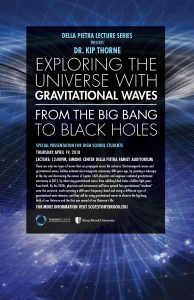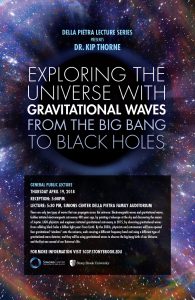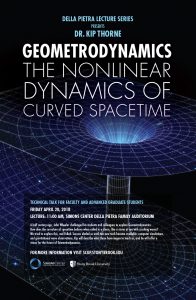Special Presentation for High School Students
 Date: Thursday April 19, 2018
Date: Thursday April 19, 2018
Lecture: 12:00 pm, Simons Center Della Pietra Family Auditorium
Title: Exploring the Universe with Gravitational Waves: From the Big Bang to Black Holes
Abstract: There are only two types of waves that can propagate across the universe: Electromagnetic waves and gravitational waves. Galileo initiated electromagnetic astronomy 400 years ago, by pointing a telescope at the sky and discovering the moons of Jupiter. LIGO physicists and engineers initiated gravitational astronomy in 2015, by observing gravitational waves from colliding black holes a billion light years from Earth. By the 2030s, physicists and astronomers will have opened four gravitational “windows” onto the universe, each covering a different frequency band and using a different type of gravitational-wave detector; and they will be using gravitational waves to observe the big-bang birth of our Universe and the first one second of our Universe’s life.
General Public Lecture
 Date: Thursday April 19, 2018
Date: Thursday April 19, 2018
Reception: 5:00pm
Lecture: 5:30 pm, Simons Center Della Pietra Family Auditorium
Title: Exploring the Universe with Gravitational Waves: From the Big Bang to Black Holes
Abstract: There are only two types of waves that can propagate across the universe: Electromagnetic waves and gravitational waves. Galileo initiated electromagnetic astronomy 400 years ago, by pointing a telescope at the sky and discovering the moons of Jupiter. LIGO physicists and engineers initiated gravitational astronomy in 2015, by observing gravitational waves from colliding black holes a billion light years from Earth. By the 2030s, physicists and astronomers will have opened four gravitational “windows” onto the universe, each covering a different frequency band and using a different type of gravitational-wave detector; and they will be using gravitational waves to observe the big-bang birth of our Universe and the first one second of our Universe’s life.
Technical Talk for Faculty and Advanced Graduate Students
 Date: Friday April 20, 2018
Date: Friday April 20, 2018
Lecture: 11:00 am, Simons Center Della Pietra Family Auditorium
Title: Geometrodynamics: The Nonlinear Dynamics of Curved Spacetime
Abstract: A half century ago, John Wheeler challenged his students and colleagues to explore Geometrodynamics: How does the curvature of spacetime behave when roiled in a storm, like a storm at sea with crashing waves. We tried to explore this, and failed. Success eluded us until two new tools became available: computer simulations, and gravitational wave observations. Kip will describe what these have begun to teach us, and he will offer a vision for the future of Geometrodynamics.
All of these lectures have been made possible by a generous donation from the Della Pietra family. The Della Pietra Lecture Series aims to bring world-renowned scientists to the Simons Center for Geometry and Physics to enhance the intellectual activity of the Center and also bring greater awareness of recent and impactful discoveries in Physics and Mathematics to the Long Island community.
For more information visit scgp.stonybrook.edu or call 631-632-2800.

